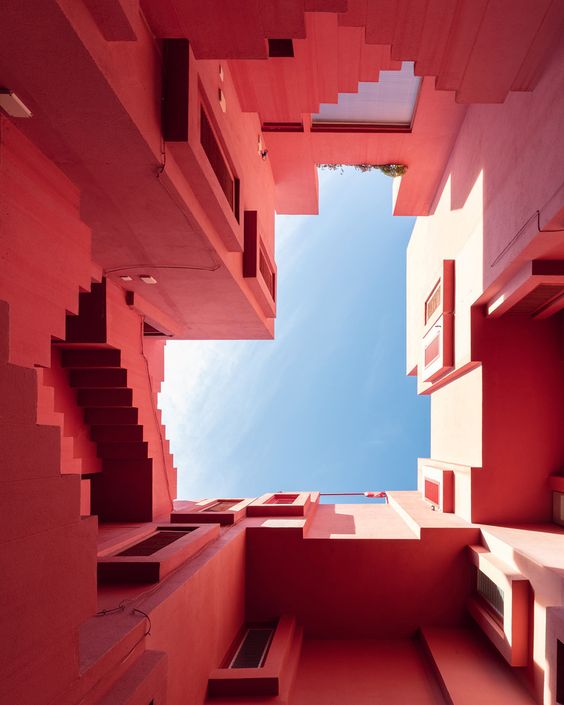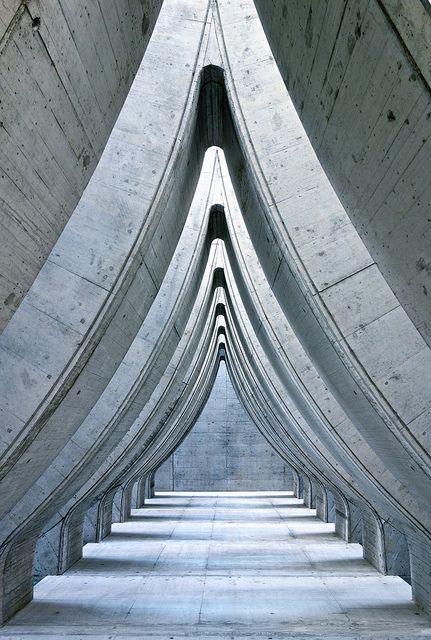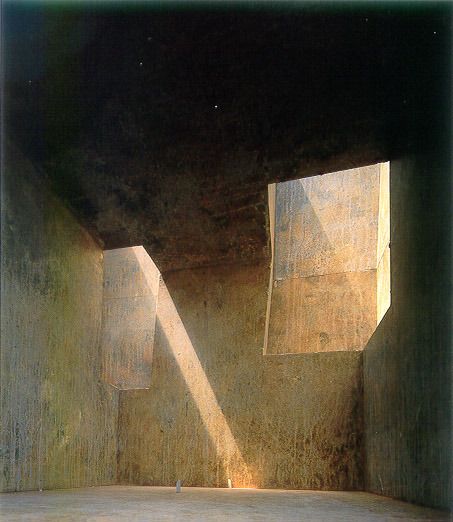The Construct Itself
Of all the artefacts the ancients left littered across the cerulean sands of Vaarn, few are more imposing than the canted bulwark of pale ferrosteel that is known variously as the Great Wall, the Weeping Wall, the Backbone of the Gods, the Titanspine, and the Sacred Impediment. The Wall forms the western boundary of the trackless Vaarnish Interior, an artificial mountain range visible from a months ride away. From a great distance it seems to be a colourless, irregular blockade that roils uneasily in the heat haze, more akin to the fortress-walls of ice that girdle the Urth’s polar regions than any work of human hands. Up close the Wall is more impressive still, a colossal ruin that stands more than four leagues in height, dwarfing even the Lazul Mountain range that embraces its northern limit. The grasping white towers that crown the summit of the edifice reach beyond the stratosphere, although the creatures that roost upon these spires do not need oxygen to survive.
Suffice to say the Wall is large; so vast that it constitutes a biosphere apart from the rest of Vaarn, and there are peoples that dwell within its recesses to whom this construct is a universe unto itself, removed from the cares of those outside. These Wallborn live and die in a vertiginous world of passageways, shafts, vents, chutes, and great ferrosteel canyons built at scale far beyond the imagining of any man, in which their towns and keeps nestle like paper wasp hives in the eaves of an abandoned granary. Many of those born in the highest reaches of the Wall have never touched the ground, and these subjects of the Queen Beyond the Sky would die before they let the blue sands sully their feet. The Wallborn are expert climbers, many lineages having modified their bodies with prehensile tails and extra hands where the feet once were, and they are as confident traversing great heights as the great apes, thinking nothing of rushing across a knotted bridge of cables with a drop of a league or more beneath them.
The purpose the ancients intended for this mighty construct is obscure, although most scholars believe the Great Wall to be a dysfunctional component of one of the Titan AIs, and given the sophistication of the engineering contained within it is difficult to dispute this notion. The Wall has been described as a colossal neural cord, intended to transfer monumental quantities of data between disparate minds. The construct appears to have served a secondary function as a coolant intake, and it is from this purpose that it is able to sustain human populations within its bounds. The Wall draws in water from the Sea of Vaarn, and transforms the liquid into pale ikor – the blood of the Machine Gods. The Wallborn drink deep of this ikor, which is ‘like nectar – it is sweet and fresh and filling, a superior fluid to water in all respects,’ according to Idris Ida-Null, the lost Hegemony Cartographer. The veins which carry this liquid are riddled with leaks and breakages, and ikor runs freely down the interior surfaces of the Wall, in trickles during some parts of the month and in great rushing floods on other days, according to the cyclical operation of the Wall’s pumps. The sites of these ikor weeps are sought after and guarded, just as the oases in the badlands of Vaarn are coveted, for the Wallborn use the ikor to nourish their livestock and irrigate the hanging gardens in which they grow many fruits.
There is a second type of ikor transported through the Wall – sable ikor, the Black Drink, a toxic brew too potent for any human to drink and live. It is whispered that certain abhuman entities covet this substance, for reasons obscure and likely inauspicious.

Flora and Fauna
There are many plants and animals that live upon the Wall and are found nowhere else in Vaarn – the long passage of millennia has brought seeds upon the wind which have lodged and germinated and found conditions to their advantage. Wherever there is an ikor weep, life sprouts in abundance. Mosses, bromeliads, vines, and even stringy, determined trees can be found growing in the crevices and passageways of the Wall. With such foliage comes herbivores – herds of mountain goats, lemurs, sloths, land snails, and other climbing grazers scale the heights to feast upon the leaves and fruits of the hanging gardens. Bats and all manner of birds can be found also, eating the insects that swarm in these inverted jungles. Predators naturally follow: troupes of carnivorous gibbons, brutish goliath geckos, sinister stalk-hawks and vantablack panthers, almost invisible unless caught in full sun. This is to say nothing of the sentient predators that haunt the upper reaches of the Wall: the Harpies, feared chimera of hawk and man who long ago abandoned their humanity in pursuit of the dream of flight.

Cities of the Wall
Two ancient and squabbling cities roost inside the Wall. The lower of the two cities is Sargattea, the Narrow City. Sargattea has grown like a scab around a raw carmine wound in the Wall, a fissure rent by some unknown power in the distant past. This passageway is the only method by which trade caravans can reach the ocean from the Vaarnish Interior, without taking a detour of hundreds of leagues that leads through the mountains or into the toxic labyrinth of Ikor Quag. Sargattea holds the Rusted Pass, and the lascannon of the Sargattean Guard will fire upon any who attempt the crossing without paying tribute.
What can be said about the Narrow City? The polity is known for its passions and its appetites. Sargatteans are famous for their bombastic poetry, for their rich wine and ornate musical romances, for the fiery and elaborate meals they prepare for guests, and for their daredevil antics on the battlefield, in business, and in the realms of love. A Sargattean who takes no lovers outside marriage is thought, or so it is claimed, to be letting the city down. Sargatteans are famous also for beetle husbandry: the city breeds pack- and war-beetles of prodigious size and excellent discipline, and these insects are one of Sargattea’s most valuable exports. The Narrow City is influenced both by the culture of the deep deserts, and by the peoples who live on the shores of Vaarn – a marriage of sand and salt, as those fond of Sargattea are heard to say. In this way the lower of the Wall’s cities is a place that embodies transformation, for travellers are forever passing through, sailors and nomads and merchants and guildsmen moving from the ocean to the desert or from the desert to the ocean, with the Narrow City a vast dressing room where actors prepare their costumes for one stage or another.
The higher of the twin cities is wind-scoured Ostriel, the City Unconquered. Ostriel is built in the upper reaches of the Wall, at the site of an ikor weep of great size and ferocity. The Ostrielese are reckoned aloof and haughty by those who trade with them, a reputation the citizens bear with pride. Where the Sargatteans are known as fiery and open, with no threat unvoiced and no compliment ungiven, the Ostrielese are by repute chilly and reserved, a people whose clothes are austere and whose greatest art is understatement. Ostriel is ruled by flocks of harpies, who gather there in great numbers to honor the Queen Beyond the Sky, the title they give to their matriarch of matriarchs. These feathered chimera own all property and control all trade in the city, and such is their ferocity and their skill in airborne combat that Ostriel has never been conquered. This boast is not made in idleness – Ostriel has gone to war many times, and although the zeppelin armadas of Sargattea have attempted to breach her defences on countless occasions during the fractious relationship between the twin cities, no Sargattean soldier has walked the streets of Ostriel save in chains, on the way to the gallows. The citizens of Ostriel take great pride in their reputation, believing the harsh weather and thin air of their roosting city to have bred a superior fighting force. The Ostrielese make a custom of never walking upon the ground, and those who find they must journey into other regions of Vaarn wear holy shoes with a harpy feather engraved on each sole, to symbolically protect them from the impurity that will otherwise seep into their bodies. Of course, the taint of such journeys can never entirely be removed, and ‘travelling’ families occupy a lower rung on the social ladder than those who have never left the heights of the Weeping Wall.
The enmity that exists between the two cities is legendary, and innkeepers throughout Vaarn know how to differentiate the accent of Sargattean and Ostrielese travellers, as mistaking one variety of Wallborn for the other can cause lethal offence. Sargatteans mock the citizens of Ostriel as slaves to feathered monsters, making loud jokes of the grotesque and humiliating sacrifices the sky-dwellers make to their harpy queen, while the Ostrielese laugh at Sargattea for the polity’s proximity to the dirt, a place fit, they claim, only for worms, faeces, and corpses. Wars break out between the two cities with metronomic regularity, and each new generation grows up learning the same litany of outrages and aggressions that have been committed by the other side. Sargattea has won more battles, or so it is claimed, but has never breached the defences of the City Beyond the Sky, whereas Ostrielese armies have sacked the Narrow City on two well-remembered occasions, once even subjecting Sargattea to rule by a puppet government of the Harpy Queen. This occupation ended generations ago, but the scars run deep, and many Sargattean collaborators with the harpy regime fled to Ostriel when the city finally rebelled. These exile families roost there even now, dreaming of the day the Narrow City will be subjugated once more by the Queen Beyond the Sky, the day Sargattea’s zeppelins burn in their bowers and grey-coated Ostrielese air-hussars patrol the streets, the day they can finally return home.
This post originally appeared in October 2020 on the Vaults of Vaarn Patreon page. Consider subscribing if you’d like to get early access to posts like this one, download Patron-exclusive PDF dungeons, and get previews of the Vaults of Vaarn zine before each issue is released. My Patrons also help support the creation of the setting.


[…] almost a year since #3 came out), but I am ready to begin work in earnest. It will concern the Wall, a decaying superstructure situated between Vaarn’s desert and the ocean. I am hoping to be […]
LikeLike
[…] production, and I’m releasing preview drafts to my Patrons monthly. This issue centers on the Great Wall of Vaarn, a colossal superstructure. The Wall is by far the largest relic of the long-ago that can still be […]
LikeLike
[…] Issue 04 is still a while off, but I have been producing content for it sporadically throughout 2022. As an early Christmas present, here’s a few of the monsters the PCs might encounter while exploring the Great Wall. […]
LikeLike
[…] is a bite-sized setting supplement, detailing a cyberpunk-ish city that lodges inside the Great Wall of Vaarn. 12 locations are detailed, along with various factions such as the Neon Court, the Chamber of […]
LikeLike
[…] within the Great Wall is profoundly different from travelling the empty wastes of the Interior. This is an attempt to […]
LikeLike
[…] Krypteia have spies and informants embedded everywhere: Ostriel, Sargattea, the wider Wall, and throughout […]
LikeLike
[…] Introductory material about the Wall […]
LikeLike